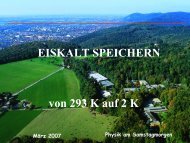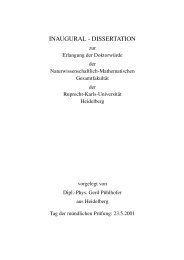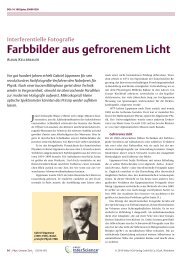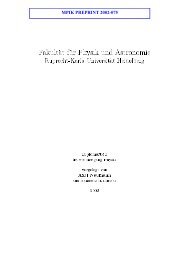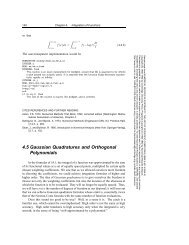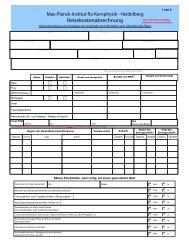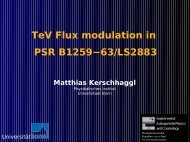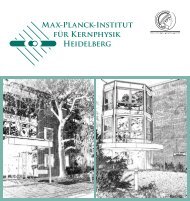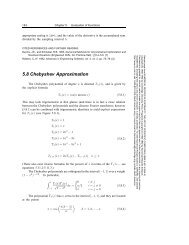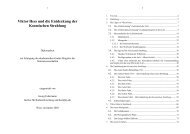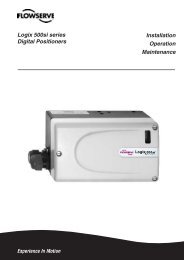15.4 General Linear Least Squares
15.4 General Linear Least Squares
15.4 General Linear Least Squares
You also want an ePaper? Increase the reach of your titles
YUMPU automatically turns print PDFs into web optimized ePapers that Google loves.
668 Chapter 15. Modeling of Data<br />
computation of the matrix inverse. In theory, since A T · A is positive definite,<br />
Cholesky decomposition is the most efficient way to solve the normal equations.<br />
However, in practice most of the computing time is spent in looping over the data<br />
to form the equations, and Gauss-Jordan is quite adequate.<br />
We need to warn you that the solution of a least-squares problem directly from<br />
the normal equations is rather susceptible to roundoff error. An alternative, and<br />
preferred, technique involves QR decomposition (§2.10, §11.3, and §11.6) of the<br />
design matrix A. This is essentially what we did at the end of §15.2 for fitting data to<br />
a straight line, but without invoking all the machinery of QR to derive the necessary<br />
formulas. Later in this section, we will discuss other difficulties in the least-squares<br />
problem, for which the cure is singular value decomposition (SVD), of which we give<br />
an implementation. It turns out that SVD also fixes the roundoff problem, so it is our<br />
recommended technique for all but “easy” least-squares problems. It is for these easy<br />
problems that the following routine, which solves the normal equations, is intended.<br />
The routine below introduces one bookkeeping trick that is quite useful in<br />
practical work. Frequently it is a matter of “art” to decide which parameters a k<br />
in a model should be fit from the data set, and which should be held constant at<br />
fixed values, for example values predicted by a theory or measured in a previous<br />
experiment. One wants, therefore, to have a convenient means for “freezing”<br />
and “unfreezing” the parameters ak. In the following routine the total number of<br />
parameters ak is denoted ma (called M above). As input to the routine, you supply<br />
an array ia(1:ma), whose components are either zero or nonzero (e.g., 1). Zeros<br />
indicate that you want the corresponding elements of the parameter vector a(1:ma)<br />
to be held fixed at their input values. Nonzeros indicate parameters that should be<br />
fitted for. On output, any frozen parameters will have their variances, and all their<br />
covariances, set to zero in the covariance matrix.<br />
SUBROUTINE lfit(x,y,sig,ndat,a,ia,ma,covar,npc,chisq,funcs)<br />
INTEGER ma,ia(ma),npc,ndat,MMAX<br />
REAL chisq,a(ma),covar(npc,npc),sig(ndat),x(ndat),y(ndat)<br />
EXTERNAL funcs<br />
PARAMETER (MMAX=50) Set to the maximum number of coefficients ma.<br />
C USES covsrt,gaussj<br />
Given a set of data points x(1:ndat), y(1:ndat) with individual standard deviations<br />
sig(1:ndat), useχ2minimization to fit for some or all of the coefficients a(1:ma) of a<br />
function that depends linearly on a, y = <br />
i ai ×afunci(x). The input array ia(1:ma) indicates<br />
by nonzero entries those components of a that should be fitted for, and by zero entries<br />
those components that should be held fixed at their input values. The program returns values<br />
for a(1:ma), χ2 = chisq, and the covariance matrix covar(1:ma,1:ma). (Parameters<br />
held fixed will return zero covariances.) npc is the physical dimension of covar(npc,npc)<br />
in the calling routine. The user supplies a subroutine funcs(x,afunc,ma) that returns<br />
the ma basis functions evaluated at x = x in the array afunc.<br />
INTEGER i,j,k,l,m,mfit<br />
REAL sig2i,sum,wt,ym,afunc(MMAX),beta(MMAX)<br />
mfit=0<br />
do 11 j=1,ma<br />
if(ia(j).ne.0) mfit=mfit+1<br />
enddo 11<br />
if(mfit.eq.0) pause ’lfit: no parameters to be fitted’<br />
do 13 j=1,mfit Initialize the (symmetric) matrix.<br />
do 12 k=1,mfit<br />
covar(j,k)=0.<br />
enddo 12<br />
beta(j)=0.<br />
enddo 13<br />
Sample page from NUMERICAL RECIPES IN FORTRAN 77: THE ART OF SCIENTIFIC COMPUTING (ISBN 0-521-43064-X)<br />
Copyright (C) 1986-1992 by Cambridge University Press. Programs Copyright (C) 1986-1992 by Numerical Recipes Software.<br />
Permission is granted for internet users to make one paper copy for their own personal use. Further reproduction, or any copying of machinereadable<br />
files (including this one) to any server computer, is strictly prohibited. To order Numerical Recipes books or CDROMs, visit website<br />
http://www.nr.com or call 1-800-872-7423 (North America only), or send email to directcustserv@cambridge.org (outside North America).



